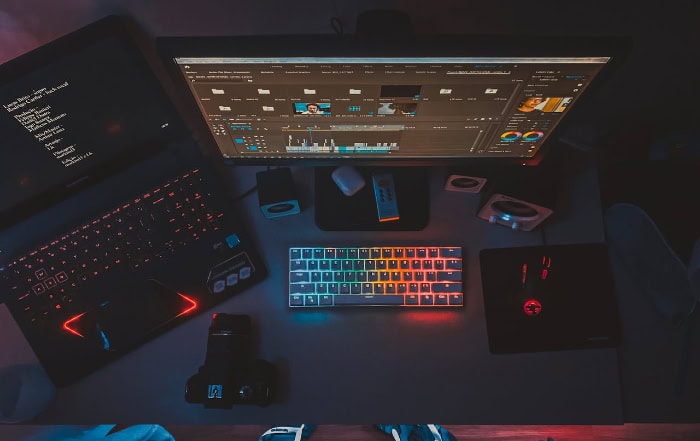What Does Remux Mean? Repackaging Digital Content

Remuxing, a term that might sound like technical jargon at first, plays a crucial role in the world of digital video processing. It’s a technique that allows video enthusiasts and professionals alike to efficiently manipulate video files without compromising quality.
If you’ve ever encountered compatibility issues when trying to play a video on different devices or platforms, remuxing could be the solution you’ve been looking for. In this article, we’ll dive into the nitty-gritty of remuxing, exploring its definition, technical process, benefits, and limitations.
Definition and Basic Concept
To grasp the essence of remuxing, let’s start by breaking down the term itself. “Remux” is derived from the words “remix” and “multiplex.”
In the context of digital video processing, remuxing refers to the process of changing the container format of a video file without altering its underlying content. This means that the video and audio streams remain untouched, while the container that houses them is swapped out for another.
Core Principle: Changing Containers Without Altering Content
The core principle behind remuxing is to change the container format of a video file while preserving the original quality of its content. A container format is essentially a file format that acts as a wrapper for various types of data, such as video, audio, subtitles, and metadata.
Some common video container formats include MP4, MKV, AVI, and MOV.
When remuxing a video, the video and audio streams are extracted from their original container and repackaged into a new one without any transcoding or re-encoding. This process ensures that the quality of the video and audio remains unchanged, as no data compression or alteration occurs during remuxing.
Relationship to Multiplexing in Digital Media
Remuxing is closely related to the concept of multiplexing in digital media. Multiplexing involves combining multiple data streams, such as video, audio, and subtitles, into a single file or transmission.
This process allows for efficient storage and transmission of multimedia content.
In the case of remuxing, the multiplexed data streams are not combined or altered. Instead, they are simply extracted from one container format and repackaged into another. This process maintains the integrity of the individual streams while allowing for greater flexibility in terms of compatibility and playback across different devices and platforms.
The Technical Process of Remuxing

Now that we’ve covered the basic concept of remuxing, let’s dive into the technical aspects of the process. Remuxing involves several steps, each of which plays a crucial role in ensuring a smooth and efficient workflow.
Remuxing Step by Step
The remuxing process typically involves the following steps:
- Demultiplexing: The first step is to extract the individual video, audio, and subtitle streams from the original container format. This process, known as demultiplexing, separates the multiplexed data into its constituent parts.
- Stream Selection: Once the streams have been extracted, the user selects which streams they wish to include in the new container. This step allows for the removal of unwanted streams or the inclusion of additional streams from other sources.
- Remultiplexing: The selected streams are then repackaged into the desired output container format. This process, called remultiplexing, combines the video, audio, and subtitle streams into a new file without altering their content.
- Output File Creation: Finally, the remuxed file is saved in the chosen output container format, ready for playback or further processing.
Remuxing Tools and Software
Several tools and software applications are available for remuxing video files. Some popular options include:
- FFmpeg: A powerful command-line tool that supports a wide range of video and audio formats. FFmpeg is highly versatile and can handle complex remuxing tasks.
- MKVToolNix: A suite of tools specifically designed for working with the Matroska (MKV) container format. MKVToolNix provides a user-friendly interface for remuxing MKV files.
- MP4Box: A command-line tool that focuses on the MP4 container format. MP4Box allows users to perform various operations on MP4 files, including remuxing.
- Avidemux: A cross-platform video editor that includes remuxing capabilities. Avidemux provides a graphical user interface, making it accessible to users of all skill levels.
These tools offer different features and cater to various user preferences, from command-line enthusiasts to those who prefer graphical interfaces.
Input and Output Formats
Remuxing supports a wide range of input and output container formats. Some of the most common formats include:
- MP4: A widely supported container format that is compatible with most devices and platforms. MP4 is often used for web streaming and playback on mobile devices.
- MKV: A flexible and open-source container format that can accommodate multiple video, audio, and subtitle tracks. MKV is popular among video enthusiasts for its versatility and ability to handle high-quality content.
- AVI: A legacy container format that was widely used in the past. While still supported, AVI has largely been superseded by more modern formats like MP4 and MKV.
- MOV: A container format developed by Apple, commonly used in Apple’s ecosystem of devices and software.
- TS: The MPEG Transport Stream format, often used for broadcasting and streaming applications.
These are just a few examples of the many container formats supported by remuxing tools. The choice of input and output format depends on factors such as compatibility, file size, and specific use case requirements.
Remuxing vs. Other Video Processing Techniques

Remuxing is just one of the many video processing techniques available to content creators and video enthusiasts. To better understand the unique characteristics of remuxing, it’s essential to compare it with other common video processing methods.
Comparison with Transcoding
Transcoding is the process of converting a video file from one format to another, often involving changes to the video and audio codecs, bitrate, resolution, or other parameters. Unlike remuxing, which only deals with the container format, transcoding alters the actual content of the video and audio streams.
This process can result in quality loss, as the video and audio data undergo compression and modification.
Transcoding is typically used when the original video format is incompatible with the target device or platform, or when there is a need to reduce the file size for storage or streaming purposes. While transcoding offers more flexibility in terms of output formats and settings, it is more time-consuming and resource-intensive compared to remuxing.
Differences from Re-Encoding
Re-encoding is a specific type of transcoding that involves decompressing the video and audio streams, making modifications, and then re-compressing them using the same or different codecs. This process is often used to adjust video parameters such as bitrate, resolution, or frame rate, or to apply filters and effects to the video content.
Like transcoding, re-encoding can result in quality loss due to the compression and decompression stages. It also requires more processing power and time compared to remuxing.
However, re-encoding offers greater control over the video and audio quality, allowing users to fine-tune the output to their specific needs.
Distinction from Video Editing and Compression
Video editing is the process of manipulating and arranging video footage to create a coherent and engaging final product. This can involve tasks such as cutting and splicing scenes, adding transitions and effects, adjusting color and brightness, and incorporating audio and graphics.
Video editing focuses on the creative aspects of video production and storytelling, rather than the technical details of file formats and codecs.
Compression, on the other hand, is a technique used to reduce the size of a video file by removing redundant or less important data. This can be achieved through various methods, such as reducing the bitrate, resolution, or frame rate, or applying more efficient codecs.
Compression is often used to optimize video files for storage, transmission, or streaming, but it can also result in a loss of quality if not done carefully.
Remuxing stands apart from video editing and compression, as it does not involve any modification to the video content itself. While remuxing can be used in conjunction with these other techniques as part of a larger video processing workflow, it serves a distinct purpose in changing the container format without altering the underlying video and audio data.
Benefits and Applications of Remuxing

Remuxing offers several significant benefits and has various applications in the world of digital video processing. From preserving the original quality of the video to improving compatibility and optimizing files for streaming, remuxing proves to be a valuable tool for content creators, distributors, and consumers alike.
Preservation of Original Quality
One of the primary advantages of remuxing is its ability to preserve the original quality of the video and audio streams. Since remuxing only deals with the container format and does not involve any re-encoding or compression, the content remains untouched.
This means that the video and audio quality is identical to the source material, ensuring that the viewer experiences the content as intended by the creator.
This preservation of quality is particularly important for high-resolution videos, such as 4K or HDR content, where even minor compression artifacts can be noticeable. By remuxing these videos into a compatible container format, users can maintain the pristine quality of the original file while still enjoying the benefits of a more suitable container.
Improved Compatibility Across Devices
Another significant benefit of remuxing is improved compatibility across various devices and platforms. Different devices and software applications support different container formats, codecs, and features.
By remuxing a video into a widely supported container format, such as MP4 or MKV, users can ensure that the file will play smoothly on a broad range of devices, from smartphones and tablets to smart TVs and gaming consoles.
Remuxing can also help resolve compatibility issues that arise when a device or platform does not support the specific codecs or features used in the original container format. For example, if a device does not support the MKV container but can handle the H.264 video codec and AAC audio codec, remuxing the MKV file into an MP4 container can enable playback on that device without the need for transcoding.
Optimization for Streaming Platforms
Remuxing plays a crucial role in optimizing video files for streaming platforms, such as YouTube, Netflix, or Twitch. These platforms often have specific requirements for container formats, codecs, and bitrates to ensure smooth playback and efficient delivery to viewers.
Content creators and distributors can use remuxing to repackage their videos into the preferred container formats and settings for each platform. This optimization process helps reduce buffering, minimize compatibility issues, and provide a better overall viewing experience for the audience.
Time Efficiency in Video Processing
Compared to other video processing techniques like transcoding or re-encoding, remuxing is a relatively quick and efficient process. Since remuxing does not involve any modification to the video and audio data, it requires less processing power and time to complete.
This time efficiency is particularly valuable when dealing with large video libraries or time-sensitive projects. Instead of spending hours or even days transcoding files, users can remux videos in a matter of minutes, allowing them to quickly prepare files for distribution or playback on different devices.
Moreover, the time saved by remuxing can be allocated to other aspects of the video production or distribution process, such as editing, quality control, or promotion.
Conclusion
Remuxing, a powerful technique in the world of digital video processing, offers many benefits for content creators, distributors, and consumers. By changing the container format without altering the video and audio content, remuxing preserves the original quality, improves compatibility across devices, optimizes files for streaming platforms, and saves valuable time in the video processing workflow.
Whether you’re a professional video editor, a content creator, or simply an enthusiast looking to get the most out of your video files, mastering the art of remuxing can open up new possibilities and enhance your overall experience. With the right tools and knowledge, you can easily adapt your videos to various platforms, devices, and requirements while maintaining the highest quality and efficiency.
So, the next time you encounter a compatibility issue or need to prepare your videos for a specific purpose, remember the power of remuxing and how it can help you achieve your goals in the vast and exciting world of digital video.


